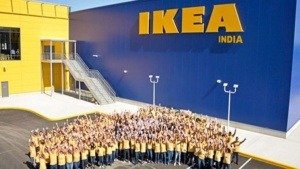
Swedish home-furnishing giant IKEA kicks off its journey in India by opening its first store in Hyderabad
 4 lakh SqFt. 13 acres. 40,000 visitors to the store on opening day. ₹12 lakh revenue at the cafeteria on day one. 1,200 parking lots for private cars and 700 parking lots for two wheelers. The Store employs 950 co-workers (nearly 50 per cent women) directly and 1,500 indirectly in services and expects to host close to 7 million visitors each year.
4 lakh SqFt. 13 acres. 40,000 visitors to the store on opening day. ₹12 lakh revenue at the cafeteria on day one. 1,200 parking lots for private cars and 700 parking lots for two wheelers. The Store employs 950 co-workers (nearly 50 per cent women) directly and 1,500 indirectly in services and expects to host close to 7 million visitors each year.
Ingvar Kamprad. The man representing IK. Elmtaryd and Agunnaryd. Farm and village respectively in Sweden where he grew up representing EA. Together, IKEA. Magic brand. Compelling story!
It was 1943. The World War II was yet to end. Europe was ravaged. Sweden was not in the thick of action, yet, it was not insulated from its destruction. In a small province called Smaland, in southern Sweden, the entrepreneur applied the lessons of the land. Resource was limited. Want was unlimited. The families had shrunk in size either due to migration or death.
The homes had shrunk in size with not enough people around to inhabit them. Smaller houses meant the old clunky ornate furniture no longer had room. They looked ugly and out of place. So it was time for bespoke furniture that looked elegant, occupied less space, had character and told a story.
Obviously this would cost an arm and a leg, right? Not really said Kamprad, the entrepreneur. Why should good furniture design be the privilege of only the rich? Why can’t it be accessible to anyone with a discerning eye? Why not indeed!
The IK of IKEA

Ingvar Kampard was born in 1926 in a small farm by the name of Elmtaryd near the village of Agunnaryd in Sweden. The region is famous for its rural agrarian society. The villagers are no stranger to hard work, egalitarianism and frugal lifestyles. These values have also been adopted by IKEA.
In 1943, when he was 17 years old, he received a cash prize from his father for doing well in his studies. He used this money to set up IKEA.
The motivating idea behind IKEA is that one and all should be able to afford modern stylish furniture.
By 1948, Kamprad had expanded his portfolio to include locally manufactured furniture, but trouble soon cropped up. By 1955 manufacturers had begun to shun IKEA, protesting Kamprad’s low prices. Kamprad, not a stranger to hard work and possessing an indomitable desire for success came up with the simple yet game changing innovation called the ‘flat-pack’.
IKEA spread throughout Sweden then Norway and Denmark and finally arrived at continental Europe and then spread like wildfire across the globe.
He passed away on 27 January, this year, aged 91. He served people through his affordable furniture
Then came the next problem. Furniture stores typically were on the outskirts and even if the furniture itself was affordable, when gas was being rationed during the war, transporting it to your home after buying it was a deal breaker. Not really, said Kamprad. What if we designed furniture that was so modular you could tuck a six seater dining table under your arm and walk away? What if indeed!
Thus was born IKEA. Designer furniture in modular form that you could take home and DIY assemble it. And here was the kicker. Champagne at beer prices (that was one of their campaigns)!
Kamprad’s story-telling didn’t stop there. Every piece of furniture came with a tag which told the story of where the wood was sourced, who designed, why it was designed the way it was, and how best it could be used. I know people who have sold their IKEA furniture but have treasure-chested these cards.
So does it surprise us that their entry into India via Hyderabad on 9th August 2018 was a Shakespearian drama which unfolded with both expected star cast and unexpected ones? It was full paisa vasool nautanki !!
4 lakh SqFt. 13 acres. 40,000 visitors to the store on opening day. ₹12 lakh revenue at the cafeteria on day one. 1,200 parking lots for private cars and 700 parking lots for two wheelers. The Store employs 950 co-workers (nearly 50 per cent women) directly and 1,500 indirectly in services and expects to host close to 7 million visitors each year.
Social media went crazy with jokes and memes. Someone said even Balaji at Tirumala had not seen this kind of a crowd. Someone else said, guys this is not a one-day exhibition, it’s a permanent store. Traffic, rain, nothing disrupted footfall to the mega furniture disruptor!
There were Virtual Reality tours of the store; the bus shelters were dressed up; bright and ornate auto rickshaws plied the young and the old; an army band played songs that reeked of nostalgia; and a happy cheerful cheering team made sure that no one, just no one, missed IKEA’s big bang entry into India!
IKEA is my favorite brand. Not just my favorite furniture brand. The furniture and furnishing industry in India is ripe for a disruption of the kind and magnitude that IKEA is expected to bring in the next five years. You don’t buy an IKEA bed because you want a bed. You buy an IKEA bed because of the possibility the bed holds. Of the experience it promises.I hope I’ll be around to enjoy it, experience it and tell its story





